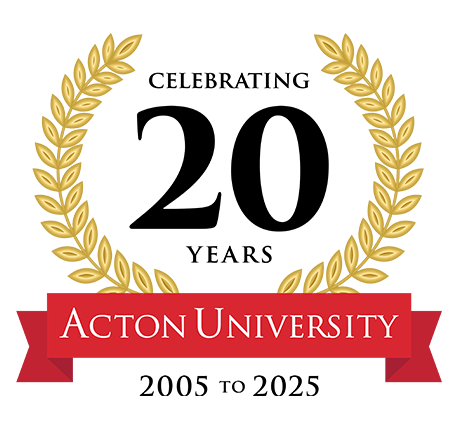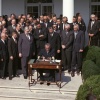R&L: Growing up in Estonia, when was the first moment that you realized there was something wrong with the Soviet system?
Laar: I couldn't actually say the exact moment. It was very early, but not too early, because my grandfather has told me some stories that I don't remember myself. I was born on the twenty-second of April, the same day Vladimir Lenin was born. I nearly gave my grandfather a heart attack when he asked once whom I loved most in the world. There are a lot of beautiful [people I could have named], including my grandfather, but I shocked him, saying that I most loved Lenin. He was really shocked that his grandson was so brainwashed. But it didn't last very long. Because when you're honest, you understand the Soviet system very quickly because the truth is so clear. The contrast between the truth and Soviet propaganda is very clear and seeable for everybody. Everything said around you was a lie—not only some things, but everything. And when you started to hear family stories, what had happened with your family, what had happened with your father, with your grandparents, it became even clearer how evil the Soviet system was. The speech President Reagan gave about the evil empire was very welcomed in Estonia. We saw the first statement really telling the truth.
In this sense, it made life easier, or it made fighting against evil easier. When you are in a situation where the lines between good and evil are not so clear, it's sometimes even more complicated. In some ways, the fight against the totalitarian system is the easy part of life.
What kept hope alive for Estonians?
When you understand how the Soviet system works, it gives you some freedom. The Soviet system is based on absolute terror and fear. So when you first kill millions or tens of millions or hundreds of millions of people, then [everyone] is just so afraid that nobody will resist. And then when you see some resistance come, it's no longer necessary to kill a million people, only to kill hundreds of people to get them back under control. To keep this fear alive, they continually need to punish somebody, to put somebody to the chain. And to keep this fear alive, it's not necessary to put people through the system because they have actually done something [against the Soviet system]. You just put someone to the chain and then everybody is more afraid. And when you understand that you can be doomed anyway, then actually you are freed because—what is the difference?
Why does communism always lead to killing people?
It couldn't be otherwise. The system is actually so unproductive, so unfair, so stupid, the people are not very eager to volunteer [for it]. To get people to go along, you must base the system on fear. So you must make people fear. And to make them afraid, the most effective way is to kill them. The communist terror has been especially effective in this. Nazi terror was selective. If you were Jewish then your family was killed. If you were just communist, [under the Nazis] your family probably survived. There were very clear rules. In the red terror, there were no rules. You could be the highest party man—maybe you were the real hangman yourself and killed hundreds of thousands of people—and it wouldn't save you. In one moment it was decided that you would disappear, and you disappear. Nobody was secure.

What would you say to those Western intellectuals who still sympathize with Marxism and question whether it would have worked had it been done a little bit differently?
I don't understand Western intellectuals who continuously support the Marxist ideas. I am always interested in asking [kids in Che Guevara t-shirts] if the next t-shirt they wear will show Hitler. I don't understand why someone who kills one or ten persons is called murderer and someone who kills hundreds of thousands of people is called a hero. And when someone kills millions of people, he is called a great statesman. That's something that is very hard to understand. And I especially don't understand the people who say that maybe communism might have worked if we had done it differently. Do what differently? Kill more people? The only way to keep communism alive is to kill significantly more people, because communism is based on massive violence and fear.
What is the difference between the way a free market looks at human beings and the way the Soviet model looks at humans?
The Soviet model of life was that the human being has no value. He is some part of the system. It's very bad to think, it's not necessary to become active. You must just listen to what is told to you. That is one reason why the system fails. The market economy, when it's a normal market, depends on the people and their activity. It trusts people. I do not say so much that the market must be trusted, but that the people must be trusted.
Describe the Estonian economy during and just after communism.
In 1939, it was hard to find two more similar countries as Finland and Estonia. We were very similar in language, culture, and living standards. Our economies were more or less the same. Then in 1940, Estonia was occupied by the Soviet Union and Finland successfully protected its independence. Look at what happened in this context during these fifty years and then you can understand how terrible the communist system really is. And it's not only in the economy. This is in all fields of life—the social structure, cultural standards, education, healthcare, or whatever. When you compare those two countries, which were exactly the same in 1939 in 1989, then you will find what communism really means, and how bad it is. Our economy, our nature, and our environment was destroyed. We were in a situation where it looked like there was no hope, no way out. When we took power in 1992, the economic situation was such that we had 1,000 percent inflation. There was no gasoline for the cars, so there were no cars in the streets. Unemployment ran somewhere around 30 percent to 40 percent. There was absolute dependence on Russia for trade. More than 92 percent of our trade was connected with Russia, so we were absolutely broken down. It couldn't have been worse. There was a huge increase of poverty and a huge increase of social inequality, and that was quite a bad picture to start. We were starting from nothing.
Can you talk about the principles that you decided were absolutely essential for forming a solid foundation for a new government?
I think the first important task we had to deal with was to wake the people up, to give them new heart. Encourage them to make decisions, to really empower them. And most of the reforms had this goal because the government couldn't change the country, only people could. And the government task in this reform was to give this power to people, and it meant a lot of reform in a lot of areas. The second principle was to do it as simply as possible because only then would it start to work. If you get too complicated, reform complicated systems to ideas and solutions, then you will probably lose so much time that you will fail. And finally, everything you do, you must do quickly because this window of opportunity was limited where the people would live with such radical measures.
Basing our activities on these three main principles, we launched different kinds of reforms, starting with the political one: We took the former communists out of office, made a smaller but more effective administration, and introduced the rule of law. Independent and democratic institutions are crucial to making a market economy work. Without them it's not possible. And then we restored property rights to the people as quickly and fast as we could to make people, owners again and not the government. I think this is one basic idea to empower the people and to give them possibilities. None of the other economic reforms have the same [force]. We encouraged Estonians to make decisions and to be responsible for their own lives.
What is the effect of competition on an economy?
I think one thing that I learned from the Milton Freedman book [ Free to Choose ] is that competition is the most important thing. To support competition, you must open your markets. So that's what I did. And, of course, I must say, a lot of these old fashioned Soviet factory workers were very angry with me. They said that we were not protecting the national industry and that it would all go down. Some [wanted] subsidies, which I refused, of course. I answered them very simply. You have now two options left, to die or to start working to produce something you can sell in the world market. And I must say, most of them decided to start working because they were good. Recon-struction was necessary. There were some countries in our neighborhood that tried to protect so-called industry, to continue the production the same way [as before], which meant that they kept production at low quality and had lower economic development.
When we compare Estonia now to Estonia fifteen years ago, actually, we don't remember very much what the country looked like. When we look at documentaries, it looks like a very old country. So we don't remember anymore because the changes have been so big. It is very hard to say what has not changed. Everything has changed. And what I like most in the changes is how the people look. [Before] people didn't look you in the eyes very much. Everybody was used to looking down, and they didn't smile. Now, there is an enormous difference. I think that this is the best sign that we have done this reform quite well.

A market in the town square, Raekoja Plats, Tallinn, Esonia. © Getty Images
Is Estonia a model for other countries?
Estonians themselves, of course, do not think that Estonians are a model. We are always dissatisfied with what we have done, because when we are not the best in the world, we are not satisfied. So when we look at how fast we are moving, when we compare ourselves with other countries, then there is some pride. But it's something new for Estonians to be models. We have been a quite small and forgotten country, victims of a lot of attacks and foreign rulers and so on.
More and more people understand this. Estonians are looked to for their experience, especially in those countries in transition from a communist to a free economy. Some people don't trust the American experts because the context from which their advice on reform is given is very different. But they know that we Estonians faced the same situations. Somehow we got out and they didn't—or haven't yet—which means that they want to listen to practical advice on how we did it.
I must say, the Estonians are pretty much like people everywhere. We have become part of the Western civilization in all good and all bad things, which means there are a lot of new challenges now ahead. But I think we are quite similar. People are always quite similar.
At the same time—this is important—Estonia gives hope. I remember when we got the first of our results in the reforms, I met Vice President Al Gore. At the end of the meeting he said, “You're not exporting a lot of goods out of the world, but you're exporting hope.” And, of course, this always makes us proud because, as I said, it must be remembered, this is not the government, not the prime minister or whomever in the government is doing this reform or making the country a model. It is the people, and the government must only empower the people and trust the people.












